|
Welcome to the November 2019 Edition of the ISEC Newsletter
In This Issue:
President's Corner
Architect's View
International Astronautical Congress
Earth Port Update
Twitter Poll Results
Today's Space Elevator
Upcoming Events
President's Corner
Thank You ISEC Supporters
November is the month of Thanksgiving -- I feel very blessed to have so many devoted "players" in the ISEC Space Elevator Community. Thank you all for your great contributions over the last year. Your diverse efforts are leading to a better future for all. Each of your contributions are significant and noteworthy. Indeed, 2019 is a pivotal year for Space Elevators. We in ISEC believe that the Space Elevator is definitely closer than you think.
Keep Climbing my friends,
Pete
Dear Fellow Space Elevator Enthusiast,
Here are some newsworthy tidbits that weren’t included in any of the below articles but deserve mention:
From Business Insider, "A Giant Elevator Could Connect Earth to Space Using Current Technology, Experts Say—Here’s How That Might Work" by Morgan McFall-Johnsen.
From Science News for Students, "Could Humans Build a Tall Tower or Giant Rope to Space?" by Carolyn Wilke.
And, a suggestion from a fellow reader, Mitchell James: from Machine Design, "Researchers Transmit Energy Using A Laser" by Stephen Mraz.
Last month we suggested perhaps a donation to help Peter Renteln's Kickstarter campaign to fund his carbon nanotube research. This month, we have another scientist with a campaign, also for carbon nanotube research. Dr. Bryan Laubscher of Odysseus Technologies, Inc. wants to build a new experimental chamber to help in going forward with his research. His fundraising platform is experiment.com and the link for his campaign is https://experiment.com/projects/designing-a-chamber-for-carbon-nanotube-synthesis-experiments.
You can support space elevators in non-monetary ways, as well. Please like us on Facebook, follow us on Twitter, and check in on our website for updates.
Sandee Schaeffer
Newsletter Editor
Home
Architect’s View
Why am I involved in Space Elevators?
It depends on one’s views.
The Rear View – Achievements since 2013
The Horizon View – It is closer than you think
The Rear View & the Horizon View of the Galactic Harbour
by Michael A. Fitzgerald
The Rear View – Achievements since 2013
The ISEC has had an impact. In the last 6 years the technical maturity and engineering substance of the Space Elevator has solidified and become organized; most notably as the Galactic Harbour. ISEC’s Technology Development and Maturation approach has melded a better definition of the Space Elevator Engineering solution(s).
The Elevator is no longer a mystery. Engineering approaches for the Tether Climber, the Earth Port, the GEO Region, and the Apex Anchor have been expressed in terms everyone understands; a harbor. The last technology hurdle – strong material for the tether – was conquered.
All we have talked with openly embraced these changes about the Space Elevator. The Galactic Harbour is a triad of change; a transportation force in the future; an enabler of robust space-based enterprise; and the initial infrastructure of the 3rd dimension of Earth’s transportation and logistics system. The Galactic Harbour…where transportation & business will meet.
The Horizon View – It is more important than you think
In the near term our major objective will be to improve the descriptive portrayals of the Horizon View and reach even broader audiences. We will portray this robust, amalgam of transportation and enterprise to attract investors, partners, educators, and supporters. At the future horizon, the Galactic Harbour will support enterprise activities along the GEO belt, factories and solar power generation near GEO, efficient interplanetary departures from the Apex, and earthbound products and materials arriving at the Earth Port. The Earth Port becomes a valued nexus of trade. On orbit, businesses will flourish, satellites will be repaired and refueled, solar power collection systems will be assembled, and interplanetary journeys will be launched. Beyond the horizon, several Galactic Harbours will operate; expanding Earth’s infrastructure to access space and melding it with the entire, diverse, mosaic of space. We will learn what God has in store for us.
I want to be around,
Michael A. Fitzgerald
Home
From the International Astronautical Congress (Wash DC 21-15 Oct 19)
by Pete Swan
Item ONE: The international space elevator community, lead by ISEC, has continued their push (since IAF 2004) to have an active space elevator technical session. This year's activity had 17 papers covering all aspects of space elevators and tethered satellites. The ISEC discussed the status of the Space Elevator as of the fall of 2019. They were:
• Today's Space Elevator (Pete Swan),
• The Technical Maturity and Development Readiness of the Galactic Harbour (Michael Fitzgerals)
• Progress Report on the Multi-stage Space Elevator (John Knapman).
• The ASU Interplanetary Initiative: Advancing Society Through Exploration (Professor Lindy Elkins-Tanton)
• Interplanetary Mission Support (Pete Swan).
• Optimization of Low Fuel and Time-Critical Interplanetary Transfers using Space Elevator Apex Anchor Release: Mars, Jupiter and Saturn (James Torla).
The technical program will be available soon on their website – https://www.iac2019.org/
Item TWO: The study report, Road to the Space Elevator Era, was displayed at the Heinlein Prize Trust Exhibit at the 70th IAC. The International Academy of Astronautics' four year study evaluates the technical readiness of the space elevator across all it major segments and comes to the conclusion that the world is on a road to space elevators. The report objectives were described In the preface: "The purpose of this study is to assess the critical technological issues and general questions and then present assessments to the Academy to ensure that the topic has been approached with an expertise and curiosity. The strength of the Academy is that it has over 1,000 senior elected members with expertise across the spectrum of the space arena. The goal of the study was to update the Academy on the status of the best approach for space elevator development, with specific focus on the critical technologies, and recommend approaches to lower the risk." The website for the book is: https://www.heinleinbooks.com
Space Elevator Leaders at Heinlein Prize Trust Booth, 25 Oct 2019, Washington, DC, International Astronautical Congress

(Left to right) Peter Swan, John Knapman, Jerome Pearson, Yoji Ishikawa. Photo by Art Dula
Home
EARTH PORT Update #13
New Images of the Earth Port’s Floating Operations Platform Created
I think that this accomplishment is worthy of such a headline. For the past few years, ISEC has been using a simple graphical image for the centerpiece of the Earth Port at sea: the Floating Operations Platform or FOP. This image was created by Nick Regnier, a Mechanical Engineering student at the time and attendee at the 2015 ISEC conference in Seattle. This image has been used in several of ISEC’s published reports and can be seen in Figures: 3-1, 3-4, 3-8, 5-11, 5-12, 8-1 and A3-1 in IAA’s recently published “Road to the Space Elevator Era” book.
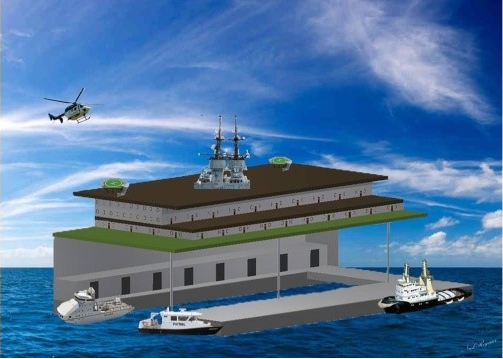
The image, however, didn’t really tell the whole story so…in order to better visualize and describe the various operational and physical attributes of the FOP, Galactic Harbour Associates (“GHA”) contracted with the Los Angeles based firm of Lux Virtual to develop a detailed computer generated series of images for this key floating structure. Here below then is the FOP as it may be seen floating in the open waters of the Pacific Ocean on or near the equator.
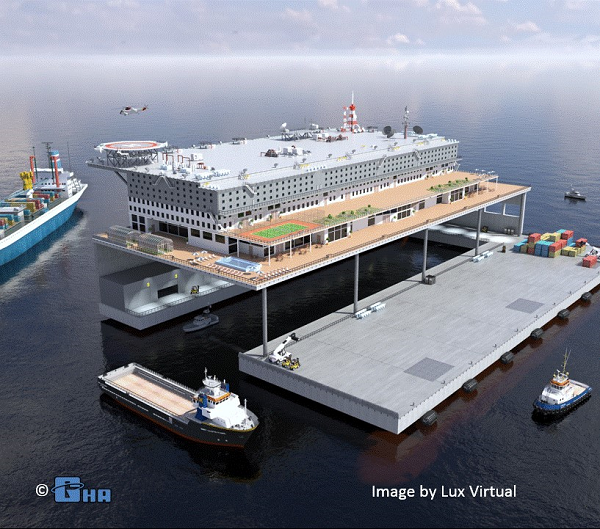
Also seen in the image is some of the Earth Port’s fleet of Ocean Going Vessels (OGVs.) In the foreground is a typical offshore service vessel that will be one of the workhorses in the daily operations of the Earth Port. These 140 ft. long vessels will transfer equipment, supplies and climber payload between the FOP and the Tether Terminus Platforms (TTPs.) Similar to their use the offshore oil industry, the open bay of these vessels, aft of the wheelhouse, will provide tremendous flexibility in moving “stuff” between the floating platforms. In the upper left corner, we see a small, 500 ft. long general cargo ship arriving at the FOP, preparing to offload cargo, supplies, equipment and payload following its 2,000 nautical mile, 5 day scheduled journey from the Earth Port Access City…possibly Honolulu as discussed in Earth Port Update # 8 (August 2017.) Also portrayed in this image are a typical harbor tugboat and a couple of patrol/fire boats. A short-range helicopter can be seen arriving or departing from the top deck of the FOP structure, moving working personnel to/from one of the TTPs.
But the above image doesn’t tell the whole story of the proposed FOP. So, let’s theoretically pull it out of the water and see what the whole structure would look like.
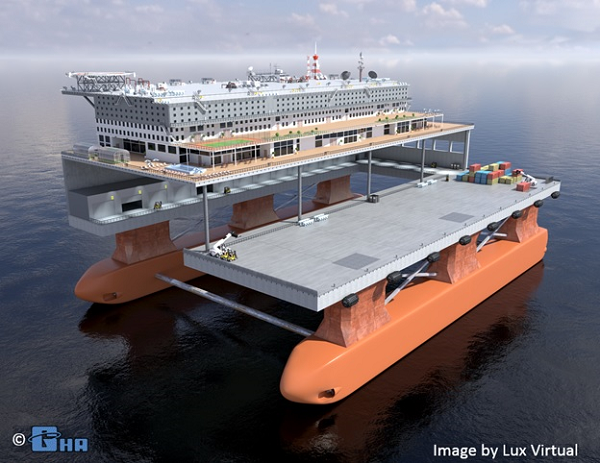
This graphic was prepared based upon the functional requirements of the Floating Operations Platform described in Section 4.3 of ISEC Position Paper #2015-1: “Design Characteristics of a Space Elevator Earth Port.” Using this image, we can begin to see how all the “pieces” fit together.
In the parlance of the world-wide Offshore Industry, the FOP will be designated as a semi-submersible platform. This concept gives it some operational mobility and allows it to function in very deep water…say over 9,000 meters…the current limit of fixed or anchored offshore drilling rigs. It will be a robust structure, designed to remain stable during typical weather and wave conditions in equatorial waters. The key features of this platform, as shown in the image above, are the twin pontoons, tied together laterally and supporting the superstructure with six large vertical struts of columns. As depicted, the overall dimensions will be: 600 ft. (183 meters) long by 400 ft. (123 m) wide by 165 ft. (50 m) height above the water line with a depth (draft) of 100 ft. (30.5 m) below the water line. The overall mass will be in the range of 50,000 to 60,000 metric tons. Although conceptually developed by a harbor engineer…me…the structure has been reviewed by naval architects and marine engineers and they have opined that it can be readily designed and constructed by today’s Offshore Industry.
The overall structure will be divided into decks from bottom to top with their primary functions summarized below:
- Pontoon Decks (red): ballast tanks, engineering spaces (power and electricity), waste control systems, desalinization plant, bow and stern thrusters
- Strut Decks (red): stairs and elevators, pipe and cable runs, A/C & ventilation equipment, auxiliary spaces
- Cargo Deck (grey): ship berthing, cargo/payload handling, passenger gangways, covered berthing for OGVs, stores and maintenance shops, payload processing work bays
- Main Deck (tan): crew, visitor and client amenities, sick bay, FOP offices, internet café, movie theater, sports facilities (note tennis court and swimming pool), dining hall, restaurant(s) and pub
- Hotel Deck (tan): crew and visitor staterooms, produce gardens, spa and beauty shops
- Operations Decks (grey): FOP bridge, payload/customer support center, oceanographic and meteorological centers, communications center, Galactic Harbour command and control center, Earth Port security operations center
- Flight Deck (light grey): helipads and drone landing/takeoff areas, communications antennae, satellite antennae, radar domes, meteorological station
I believe that these images will help ISEC develop its “story” and will show potential participants that the Earth Port element can be defined, designed, constructed and operated in the near future. In fact, it will be necessary to do this in order to provide a working base for testing and development of the other key elements of the Galactic Harbour system. These test operations need to begin as early as possible to mentor Galactic Harbour segments through Engineering Validation activity; tests and demonstrations managed through the Operations Decks cited above; home to the Galactic Harbour’s Headquarters/Primary Operations Center (“HQ/POC”.)
Vern Hall
Earth Port Harbor Master
Home
Twitter Poll Results
This last month Peter Robinson conducted an impromptu poll on Twitter to ask for views on the single reason for an Earth Space Elevator. Please keep in mind that Twitter only allows up to four options in a simple poll, with only 25 characters allowed for each. This restricts the scope of the choices in to very general buckets; When we sent this out it was re-tweeted from the ISEC, BIS and other accounts, and we were able to reach just over 2,600 people and we received 54 poll results.
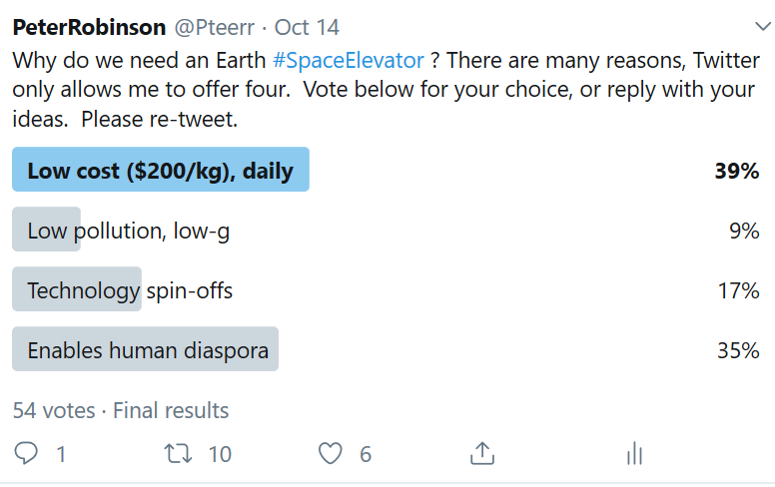
The winner was as expected the financial one: “Low cost $200/KG, daily” pulling in 39%.
We were surprised to see the #2 slot going to “Enables human diaspora” with 35%!
The “Technology spin-offs” came in third with 17% and
The “Low pollution, low-g” rounded out the field with the remaining 9%
Since our number of responses were too low to use for statistical analysis we are planning to run this poll again and we would like to hear from you what you would like the buckets to be for this poll and we would love to get your input and opinion. We are asking for your help to get the word out there when we run this again to get greater participation in the poll.
Here is what we have in mind right now:
- Affordable space travel
- Enables human diaspora
- Cool tech advances
- Cleaner space launches
Other options:
- Global space access
- Recreation
- Research
We will let you know in advance of the poll to help give people time to get the word out
Home
Today's Space Elevator
List of over 750 References
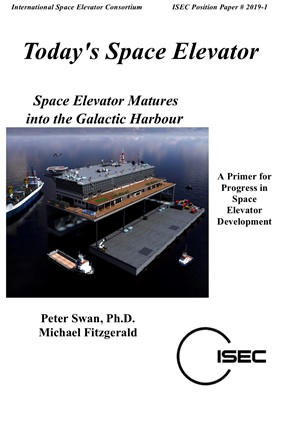
Last month we talked about the new book: Today's Space Elevator. It is an update on the status of the program as of the Fall of 2019. You can "Get It Now!" from our website, www.isec.org in pdf - for free. In addition to a great read about its status, the document has an amazing set of appendices. The one I believe to be the most significant is the list of references for space elevators over the last several years: books, study reports, papers, and presentations. There are over 750 individual items - researchers should revel at this list that is broken into different categories. The appendices are:
Appendix A: Frequently Asked Questions
Appendix B: Space Elevator Terminology
Appendix C: Summary of ISEC Studies
Appendix D: Summary of IAA Studies
Appendix E: Summary of ISEC Architectural Notes
Appendix F: Space Elevator References
Appendix G: ISEC Description
The first one - Frequently asked questions - should be the "go to" source for space elevator answers. Of course, we have included all ten studies by ISEC and two by the International Academy of Astronautics. Plus, our Chief Architect's Notes are a fun read that explains where we are in the flow of our mega-program development. The book is designed to update the status of the Space Elevator program and provides as many supporting items as possible.
Home
Upcoming Events
The British Interplanetary Society’s 17th Reinventing Space Conference
http://rispace.org/
12-14 November 2019
International Convention Centre (ICC)
2 Lanyon Place
Belfast, BT1 3WH
Our own Peter Robinson will be speaking 13 November on the History, Status, and the Future of Space Elevators.
Home
|
